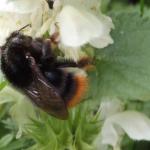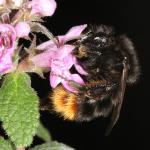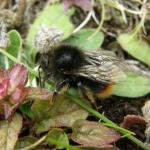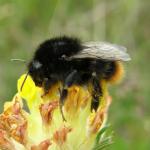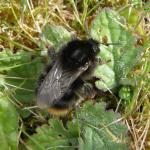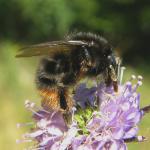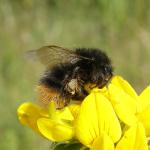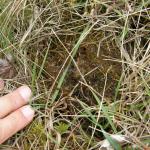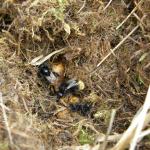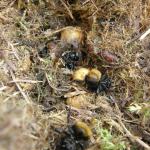The Red-shanked carder bee resembles a smaller, rounder, version of the common and widespread Red-tailed bumble bee, Bombus lapidarius, but has red hairs (not all black) on the corbicula. Keys and general biology are found in Sladen (1912), Free & Butler (1959), Alford (1975) and Prŷs-Jones & Corbet (1991).
This species has seen a catastrophic decline in its abundance and distribution throughout the British Isles since the first half of the century. Direct comparison with the map published in the 1980 Atlas (Anon. 1980) is difficult as much of the data supporting the Atlas map is not present in the IBRA archive. All such unsubstantiated data is not shown on the map. The current map does, however, reflect the intense recording activity of the past three years (1998-2000) under the UK Biodiversity Action Plan Bumblebee Project. The strongest modern populations correspond with the larger areas of unimproved grasslands, for instance on the Hebridean Isle of Tiree, although the species may survive in areas of least intensified farmland.
The species ranges from southern Fennoscandia south to the Mediterranean, and east to Russia, western Siberia and northern Kazakhstan (Lfken, 1973). It is declining throughout Western Europe.
Not listed as scarce or threatened by Falk (1991) but its numbers have apparently declined greatly in recent years and there is now some concern over its true status.
See description and notes above.
Extensive areas supporting a variety of flowering plant species, typically from the plant families Fabaceae and Lamiaceae. It is vital that suitable forage is available throughout the flight period of the colony.
The first queens leave their hibernation sites from mid- to late April onwards (there has been the occasional sighting in March). Sladen (1912) records this species as the first of the carder bees to commence nesting each year. The colony dies during August or early September.
In spring each fertile queen constructs a nest of grass clippings and moss on the ground under cover of long vegetation or slightly underground, often utilising an old mouse nest as a foundation. The colony has between 50 and 100 individuals at maturity (von Hagen, 1994). Males and females are produced at the end of July and during August. Once the new sexual forms have hatched the nest disintegrates, the mated queens go into hibernation whilst the workers and males can be found on flowers before eventually dying. The hibernation site for queens is unknown.
A large number of plants are visited for nectar; pollen collection is more restricted, with Fabaceae, Lamiaceae and Scrophulariaceae being particularly favoured.
None specifically recorded in Britain. Psithyrus campestris has been recorded in Germany (Westrich, 1989).
2000


